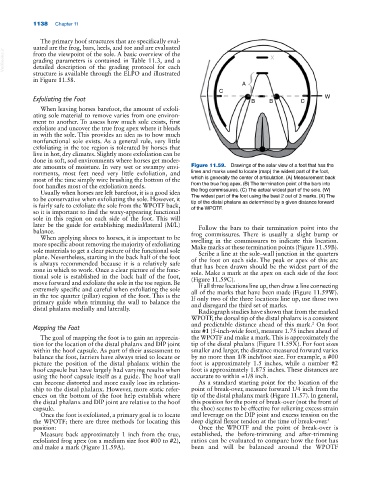Page 1172 - Adams and Stashak's Lameness in Horses, 7th Edition
P. 1172
1138 Chapter 11
The primary hoof structures that are specifically eval
uated are the frog, bars, heels, and toe and are evaluated
VetBooks.ir grading parameters is contained in Table 11.3, and a X
from the viewpoint of the sole. A basic overview of the
detailed description of the grading protocol for each
structure is available through the ELPO and illustrated
in Figure 11.58.
A
C
Exfoliating the Foot B B C W
When leaving horses barefoot, the amount of exfoli
ating sole material to remove varies from one environ
ment to another. To assess how much sole exists, first
exfoliate and uncover the true frog apex where it blends
in with the sole. This provides an idea as to how much
nonfunctional sole exists. As a general rule, very little
exfoliating in the toe region is tolerated by horses that
live in hot, dry climates. Slightly more exfoliation can be
done in soft, sod environments where horses get moder
ate amounts of moisture. In very wet or swampy envi Figure 11.59. Drawings of the solar view of a foot that has the
ronments, most feet need very little exfoliation, and lines and marks used to locate (map) the widest part of the foot,
most of the time simply wire brushing the bottom of the which is generally the center of articulation. (A) Measurement back
foot handles most of the exfoliation needs. from the true frog apex. (B) The termination point of the bars into
Usually when horses are left barefoot, it is a good idea the frog commissures. (C) The actual widest part of the sole. (W)
to be conservative when exfoliating the sole. However, it The widest part of the foot using the best 2 out of 3 marks. (X) The
is fairly safe to exfoliate the sole from the WPOTF back, tip of the distal phalanx as determined by a given distance forward
so it is important to find the waxy‐appearing functional of the WPOTF.
sole in this region on each side of the foot. This will
later be the guide for establishing medial/lateral (M/L) Follow the bars to their termination point into the
balance. frog commissures. There is usually a slight bump or
When applying shoes to horses, it is important to be
more specific about removing the majority of exfoliating swelling in the commissures to indicate this location.
Make marks at these termination points (Figure 11.59B).
sole materials to get a clear picture of the functional sole Scribe a line at the sole–wall junction in the quarters
plane. Nevertheless, starting in the back half of the foot of the foot on each side. The peak or apex of this arc
is always recommended because it is a relatively safe that has been drawn should be the widest part of the
zone in which to work. Once a clear picture of the func sole. Make a mark at the apex on each side of the foot
tional sole is established in the back half of the foot, (Figure 11.59C).
move forward and exfoliate the sole in the toe region. Be If all three locations line up, then draw a line connecting
extremely specific and careful when exfoliating the sole all of the marks that have been made (Figure 11.59W).
in the toe quarter (pillar) region of the foot. This is the If only two of the three locations line up, use those two
primary guide when trimming the wall to balance the and disregard the third set of marks.
distal phalanx medially and laterally.
Radiograph studies have shown that from the marked
WPOTF, the dorsal tip of the distal phalanx is a consistent
2
and predictable distance ahead of this mark. On foot
Mapping the Foot size #1 (5‐inch‐wide foot), measure 1.75 inches ahead of
The goal of mapping the foot is to gain an apprecia the WPOTF and make a mark. This is approximately the
tion for the location of the distal phalanx and DIP joint tip of the distal phalanx (Figure 11.59X). For foot sizes
within the hoof capsule. As part of their assessment to smaller and larger, the distance measured forward varies
balance the foot, farriers have always tried to locate or by no more than 1/8 inch/foot size. For example, a #00
picture the position of the distal phalanx within the foot is approximately 1.5 inches, while a number #2
hoof capsule but have largely had varying results when foot is approximately 1.875 inches. These distances are
using the hoof capsule itself as a guide. The hoof wall accurate to within ±1/8 inch.
can become distorted and more easily lose its relation As a standard starting point for the location of the
ship to the distal phalanx. However, more static refer point of break‐over, measure forward 1/4 inch from the
ences on the bottom of the foot help establish where tip of the distal phalanx mark (Figure 11.57). In general,
the distal phalanx and DIP joint are relative to the hoof this position for the point of break‐over (not the front of
capsule. the shoe) seems to be effective for relieving excess strain
Once the foot is exfoliated, a primary goal is to locate and leverage on the DIP joint and excess tension on the
the WPOTF; there are three methods for locating this deep digital flexor tendon at the time of break‐over. 4
position: Once the WPOTF and the point of break‐over is
Measure back approximately 1 inch from the true, established, the before‐trimming and after‐trimming
exfoliated frog apex (on a medium size foot #00 to #2), ratios can be evaluated to compare how the foot has
and make a mark (Figure 11.59A). been and will be balanced around the WPOTF

